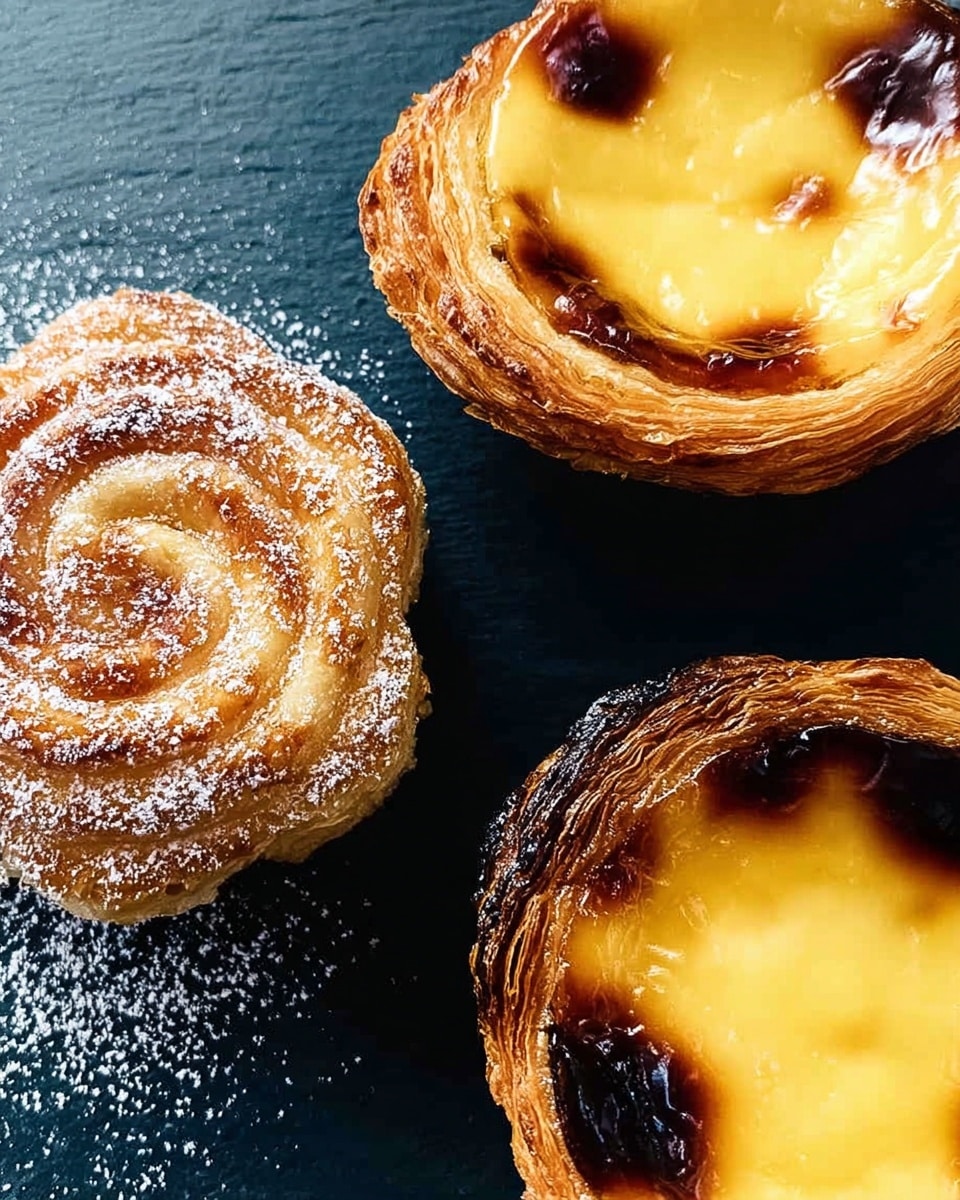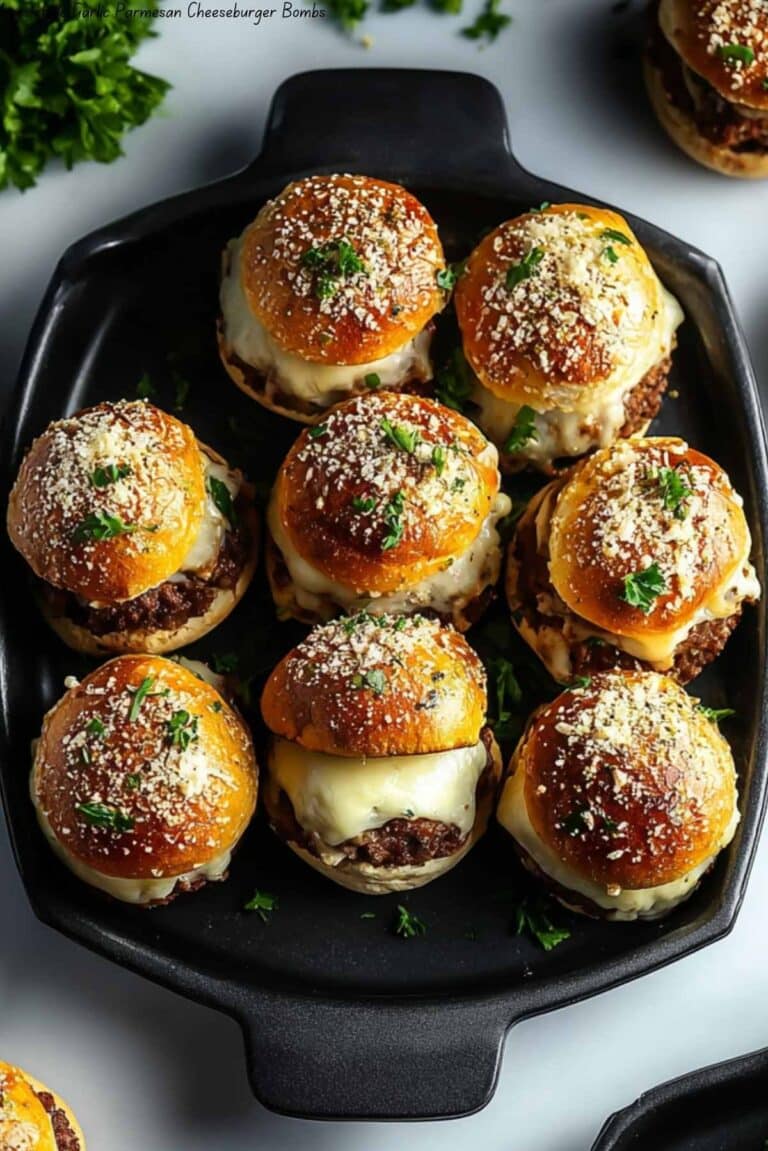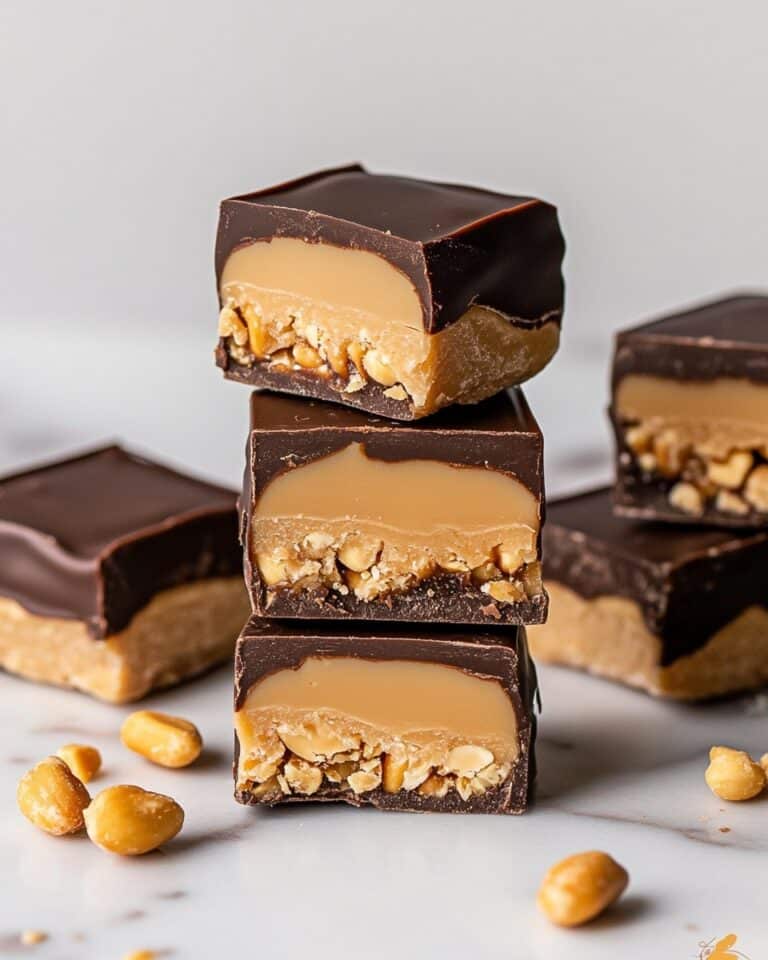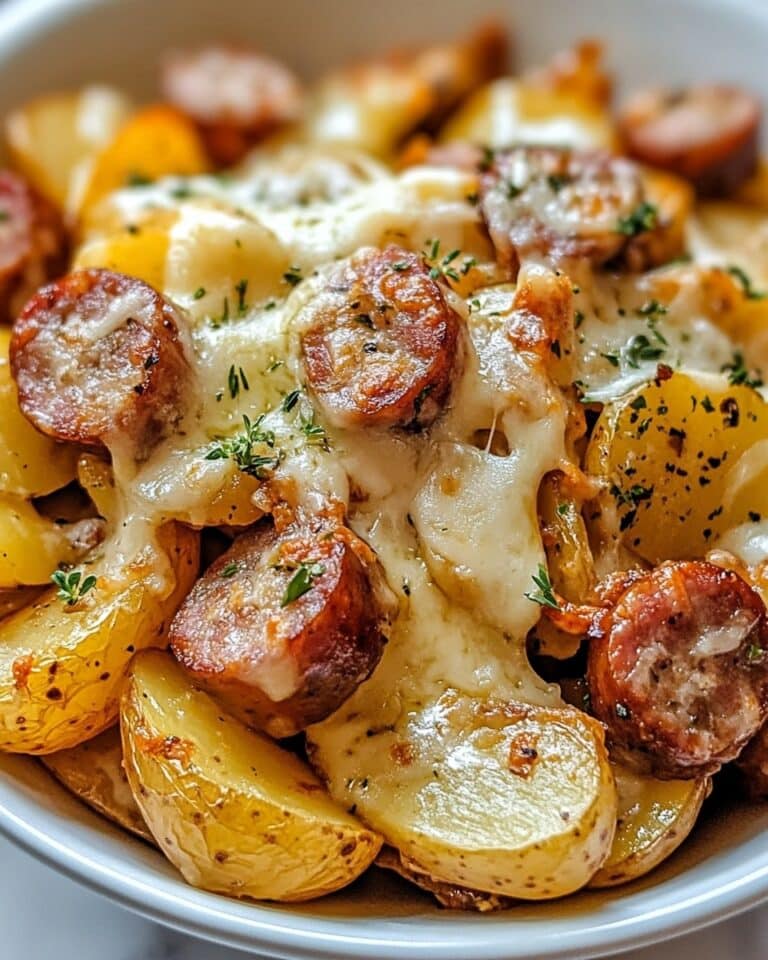Portuguese Custard Tarts (Pasteis de Nata) Recipe
Ah, Portuguese Custard Tarts (Pasteis de Nata) – they’re the kind of treat that makes you feel like you’ve stepped into a cozy Lisbon café. These little golden beauties have a flaky, buttery crust and a custard filling that’s smooth and just lightly caramelized on top. Whenever I bake them at home, I find it’s like bringing a slice of Portugal right into my kitchen, perfect for afternoon tea or a special weekend indulgence.
What makes this Portuguese Custard Tarts (Pasteis de Nata) recipe so special is that it combines a homemade rough puff pastry with a rich, creamy custard that sets just right. I love sharing these with friends because they never last long, and their balance of textures and flavors is genuinely irresistible. Give this recipe a try — you’ll see what I mean once you bite into that crispy, flaky shell paired with the silky filling!
Ingredients You’ll Need
Each ingredient in this recipe plays an important role—whether it’s creating that perfect flaky pastry or a custard that wobbles just enough. I always recommend using fresh, high-quality dairy and eggs to get the best flavor and texture.
- Homemade rough puff pastry: Trust me, making your own puff pastry here is a game-changer for authenticity and crunchiness. Store-bought versions just don’t hit the same.
- Heavy cream: Adds richness to the custard and helps create a creamy texture that’s not too runny.
- Sugar (granulated white): Sweetens the custard and helps with that gorgeous caramelized top.
- Whole milk: Essential for balancing richness and lending a smooth mouthfeel to the custard.
- Egg yolks: The magic ingredient for that custard’s signature color and silky finish.
- Cornstarch: This keeps the custard stable and creamy — don’t skip it.
- Vanilla extract: Just a little punch of flavor to round out the custard’s profile.
Variations
I like experimenting with these tarts sometimes, especially when I’m feeling a bit adventurous. You can easily tweak the recipe to suit your mood or what you’ve got on hand.
- Spiced twist: I once added a pinch of cinnamon and nutmeg to the custard, and it made the tarts feel a little warmer and perfect for cooler days.
- Dairy-free version: Substituting coconut cream for heavy cream and a plant-based milk for whole milk works surprisingly well — great if you’re avoiding dairy.
- Lemon zest infusion: A bit of lemon zest grated into the custard adds a subtle brightness that’s refreshing and unique.
How to Make Portuguese Custard Tarts (Pasteis de Nata) Recipe
Step 1: Prepare Your Puff Pastry Shells
If you want the authentic Macau Egg Tart texture, homemade rough puff pastry is your best friend here. Roll it out until it’s about 3-4mm thick, then cut rounds slightly larger than your tart tins. Press the dough gently into the tins, making sure there are no air bubbles trapped. I like to chill the shells while I prepare the custard to help them keep their shape.
Step 2: Make the Custard Filling
In a saucepan, combine heavy cream, sugar, whole milk, and vanilla. Warm over medium heat, stirring until sugar dissolves. Whisk egg yolks and cornstarch until smooth, then slowly pour the warm milk mixture over them while stirring continuously to avoid scrambling. Pour this mixture back into the pan and cook gently, stirring, until it thickens to a pourable custard consistency – it shouldn’t boil.
Step 3: Fill the Tart Shells
Ladle the custard carefully into the chilled pastry shells, filling them up to just below the rim. I find it helps to let the custard cool slightly before pouring so it doesn’t make the pastry soggy. Don’t overfill — those tarts puff up a bit while baking.
Step 4: Bake Until Golden and Caramelized
Preheat your oven to a high temperature – around 250°C (480°F) works magic. Bake the tarts for about 12-15 minutes or until the tops are speckled with brown spots and the pastry edges are deeply golden. Keep an eye on them; every oven’s different. That little caramelization is what really makes these tarts sing!
How to Serve Portuguese Custard Tarts (Pasteis de Nata) Recipe
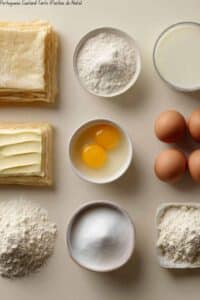
Garnishes
I usually sprinkle a tiny pinch of cinnamon on top right after baking – it adds a warm aroma that lifts the flavor just beautifully. Some folks love a dusting of powdered sugar or even a little lemon zest for a fresh twist. Keep it simple and classic if you want that authentic vibe.
Side Dishes
These custard tarts go great with a cup of strong espresso or a fresh herbal tea. I sometimes serve them alongside some fresh berries or a light salad if it’s a brunch situation. You want the tart to really shine, so keep the sides complementary but not overwhelming.
Creative Ways to Present
For parties, I like arranging the tarts on a rustic wooden platter with a scattering of edible flowers or fresh mint leaves. It adds a bit of color and makes the table feel inviting. Another fun idea is to serve them warm in individual mini cast iron pans for that cozy touch.
Make Ahead and Storage
Storing Leftovers
If you have leftovers (which might be tough!), store them in an airtight container in the fridge. They’re best eaten within 2 days because that flaky crust can lose its crispness pretty quickly. I usually just warm mine up the next day before indulging again.
Freezing
I’ve frozen these tarts after baking with decent results—wrap each tart tightly in plastic wrap and place in a freezer-safe bag. Thaw overnight in the fridge, then reheat in a hot oven to bring back the crunchy pastry and warm custard. Avoid microwaving as it can make the crust soggy.
Reheating
To reheat, pop the tarts in a preheated oven at about 180°C (350°F) for 5-7 minutes. This revives the crisp pastry perfectly while gently warming the custard inside. It’s a simple trick to bring that fresh-out-of-the-oven feeling back!
FAQs
-
Can I use store-bought puff pastry for Portuguese Custard Tarts (Pasteis de Nata) Recipe?
While you technically can, I highly recommend making homemade rough puff pastry to get that authentic flaky texture and buttery flavor. Store-bought puff pastry is more delicate and can turn out less crispy, which changes the whole experience of a Portuguese Custard Tart.
-
How do I prevent the custard from curdling?
Slowly temper the egg yolks by gradually adding the warm milk mixture while whisking constantly. Also, cook the custard over low to medium heat without letting it boil; high heat can cause curdling. Stir continuously to keep it smooth and creamy.
-
Why do my Portuguese Custard Tarts have a soggy bottom?
Make sure the tart shells are well chilled before adding the custard, and don’t overfill. Also, baking at a high temperature helps set the pastry quickly for a crisp base. Using homemade rough puff pastry also improves texture and prevents sogginess.
-
Can I add other flavors to the custard?
Absolutely! Small amounts of cinnamon, nutmeg, or citrus zests like lemon work beautifully. Just be careful not to overpower the classic vanilla custard flavor.
-
What’s the best way to reheat Portuguese Custard Tarts (Pasteis de Nata)?
The best way is oven reheating at around 180°C (350°F) for 5-7 minutes to bring back crispiness without drying out the custard. Avoid the microwave, which tends to make pastry soggy.
Final Thoughts
Making Portuguese Custard Tarts (Pasteis de Nata) at home is one of those cooking projects that feels so rewarding – especially when you pull that first warm, caramelized tart from the oven. The balance of flaky pastry and creamy custard always surprises me and delights anyone who tries them. I hope you’ll give this recipe a go and find as much joy in baking and sharing them as I do. Trust me – once you’ve mastered it, there’s no going back to store-bought versions!
PrintPortuguese Custard Tarts (Pasteis de Nata) Recipe
Portuguese Custard Tarts, also known as Pasteis de Nata, are a beloved traditional Portuguese pastry featuring a crispy, flaky puff pastry crust filled with a rich, creamy egg custard that is caramelized on top. These tarts are best enjoyed warm, boasting a perfect balance between a smooth, sweet custard and a buttery crust. This recipe uses homemade rough puff pastry to achieve the authentic texture and flavor, making it a delightful treat for any occasion.
- Prep Time: 30 minutes
- Cook Time: 15 minutes
- Total Time: 45 minutes
- Yield: 12 tarts 1x
- Category: Baking
- Method: Baking
- Cuisine: Portuguese
Ingredients
Pastry
- 420 g homemade rough puff pastry
Custard Filling
- ½ cup heavy cream (35% fat dairy cream, 118 ml)
- ½ cup granulated white sugar (115 g)
- 1 ¼ cup whole milk (300 ml, 3.5% milk fat)
- 2 egg yolks
- 4 teaspoons cornstarch (11 g)
- 1¼ teaspoon vanilla extract
Instructions
- Prepare the Pastry: Roll out the homemade rough puff pastry into a thin sheet. Cut the pastry into rounds or squares large enough to line your tart molds or muffin tin. Gently press the pastry into the molds ensuring an even layer with no tears.
- Make the Custard: In a medium saucepan, combine the heavy cream, whole milk, and sugar. Heat gently over medium heat, stirring occasionally until the sugar dissolves and the mixture is warm but not boiling.
- Mix Cornstarch and Yolks: In a separate bowl, whisk the egg yolks and cornstarch until smooth and slightly thickened. Slowly pour a small amount of the warm milk mixture into the yolk mixture to temper the eggs, whisking continuously to avoid curdling.
- Combine and Cook Custard: Pour the tempered yolk mixture back into the saucepan with the remaining milk mixture. Cook over medium-low heat, stirring constantly until the mixture thickens to a custard-like consistency, approximately 5-7 minutes. Remove from heat and stir in the vanilla extract.
- Fill the Tarts: Spoon the warm custard into the prepared pastry shells, filling each nearly to the top but without spilling over.
- Bake: Preheat the oven to 250°C (482°F) or as high as your oven will allow for a good caramelization. Bake the tarts for 12-15 minutes or until the pastry is golden and puffed, and the custard develops characteristic dark spots on top.
- Cool and Serve: Let the tarts cool in the molds for a few minutes before transferring to a wire rack to cool further. Serve warm or at room temperature for the best flavor.
Notes
- Using homemade rough puff pastry is essential for an authentic texture and flavor; store-bought pastry may result in a less flaky crust.
- High oven temperature is key to achieving the characteristic caramelized top of Portuguese custard tarts.
- Be careful when tempering the egg yolks to avoid cooking them prematurely, which can cause curdling.
- These tarts are best eaten fresh but can be stored in the refrigerator for up to 2 days and rewarmed before serving.
- For an extra touch, sprinkle a little cinnamon or powdered sugar on top before serving.
Keywords: Portuguese custard tarts, Pasteis de Nata, egg tart, puff pastry, traditional Portuguese dessert, homemade custard tart

